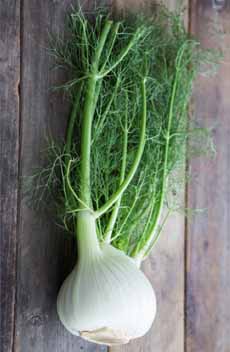RECIPE: Chopped Fennel & Apple Salad
|
This crunchy chopped salad is a smooth transition from summer to heartier winter salads. It’s based on what we think is an under-used vegetable, fennel, which is in season from early fall to early spring. Crisp fennel and crisp apple combine with crunchy pomegranate arils, which add a festive touch. (Don’t like arils? Try this fennel and arugula salad with apple and orange. We’re also fond of these fennel pickles.) This recipe comes to us from Beth Warren Nutrition. Beth is the author of two books, Living a Real Life with Real Food (2014) and Kosher Girl, due in spring 2018. Her focus is health-conscious kosher meals; but you don’t have to be kosher to enjoy every bite. Beth likes this recipe for Rosh Hashanah. It goes splendidly with yesterday’s recipe for Buttermilk Roast Chicken. Also take a look at this Orange Fennel Salad recipe, this Shaved Salad With Pear & Fennel, and these Fennel Pickles. Ingredients For 4-6 Servings 1. COMBINE the ingredients in glass mixing bowl. Sprinkle salt and pepper to taste. Fennel looks like the offspring of a peeled white onion and a bunch of dill. It’s crunchy like celery, with a slight anise taste. |
[2] A bulb of fennel. All parts can (and should!) be eaten (photo courtesy Good Eggs). |
|
|
You can use every part of it. Fennel is highly aromatic and flavorful, with a long history of both culinary and medicinal uses. The bulb and stalks resemble celery, the leaves look like dill (Anethum graveolens, also of the same order and family), and the aroma and flavor resemble sweet licorice (Glycyrrhiza glabraa, a totally different order [Fabales] and family [Fabaceae]). A member of the parsley family* (Apiaceae), fennel (Foeniculum vulgare) and celery (Petroselinum crispum) are botanical cousins, members of the same order* (Apiales) and family* (Apiaceae). Both are believed to be indigenous to the shores of the Mediterranean, growing wild before they were cultivated thousands of years ago. Records of fennel’s use date back to about 1500 B.C.E, although its use far precedes the records. Fennel was likely first cultivated in Greece, and was used for both medicinal† and culinary purposes. The ancient Greeks and Romans ate the entire plant: the bulb, the the seeds, blossoms and the fronds. Theirs was a more bitter variety. Florence fennel, also called sweet anise and finocchio in Italian, the variety eaten as a vegetable, wasn’t developed until the 17th century, in the area of Florence, Italy [source]. Although many recipes make reference to fennel “root,” it is actually the stalk, swollen into a bulb-like shape at the plant’s base, which is consumed (the same is true with kohlrabi). Uses For Fennel Fennel can be substituted for celery in recipes when an additional nuance of flavor is desired. We also enjoy it as part of a crudités plate. Fennel seeds are a popular spice, for baking, bean dishes, brines, fish, pork, sausages and much more. We especially like them in cole slaw and cucumber salad. Plain and sugar-coated fennel seeds are used as a spice and an after-meal mint in India and Pakistan. If you don’t see a dish of them as you leave, ask for them at restaurants. In case you don’t remember plant taxonomy from high school biology, here’s a refresher. †Pliny The Elder mentions fennel as a treatment for stomachache, the “stings of serpents,” uterus health and other maladies. Those ancient homeopaths got it right: According to Web MD, modern uses include various digestive problems, such as heartburn, intestinal gas, bloating, loss of appetite and colic in infants. It is also used for upper respiratory tract infections, coughs, bronchitis, cholera, backache, bedwetting, and visual problems. Some women use fennel for increasing the flow of breast milk, promoting menstruation, easing the birthing process, and increasing sex drive. And yes, fennel powder is used as a poultice for snakebites.
|
||




